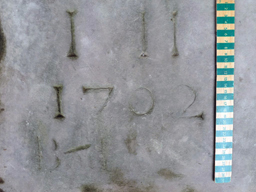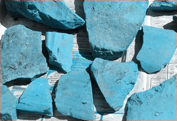 
The project at the All Saints Parish Church Yard in Wigan has finally got underway. This project, which was first reported in last June's newsletter (No.124), involves the resetting of the paving slabs in front of the Church. We have been asked to conduct a watching brief and record any features which may appear underneath them.The work is contracted out to the Groudwork Trust whose workmen have been helping us to keep a close eye on the stones as they have been lifted. So far nothing of significance as shown up; however we have a daily presence on site so we will be able to record anything that does appear.
In fact we are also taking the opportunity, whilst the area is cordoned off, to record the wellworn inscriptions which appear on the upper surfaces of some of these slabs.
Rectory Update

Excavations at the Rectory are carrying on at a pace. We now have the width of the stoney path (reported in last month's newsletter). It is also clear that the cinder we uncovered is spread over a wide area and is therefore unlikely to be part of a path. More probably it was dumped there when the path went out of use (we know the path became redundant some time in the last century, when tennis courts were built to the west side of the hall). Another feature beginning to develop is a compacted sandy patch which has stones in it. It seems to be contemporary with the cinder and may have been put down as a base for a small shed or something similar. All these features have been recoded now so we can take them up and progress to the next levels (hopefully it's the old Frog Lane). Next month, students from Winstanley A level College will be joining us for a one day session. Eric Walter will be letting those interested have details of our next site visit.
Roman Extravaganza
Two days of events celebrating Roman Wigan have taken place last week in the Grand Arcade. The events were arranged by Wigan Leisure and Culture Trust and included children and the general public handling Roman finds and dressing up as Roman Soldiers. Ian Miller was also on hand to describe what was found when the Grand Arcade was built. We also had a presence there and during the two days a good deal of interest was shown in our society and what we've been doing.
New Chairman
It is with great regret that we have had to ask Tom Glover, our chairman, to leave the society. This is because a few weeks ago it came to light that a project is being run in Mesnes Park under the society's name - but without its knowledge. The project is to locate the Pulham waterfall ram-pump which is something we first got involved with in 2004 (see Newsletter 78). Tom has been unwilling to share with us, or even explain to us, what he has been doing and so we feel we have been left with no alternative. This is regretfully situation but hopefully the membership will understand the committee's position and offer them support. This, hopefully, will bring to a close, what everybody would agree, has been a difficult year for us. We are now left without a chairman; however Eric Walter has kindly offered to stand in until we can elect a new chairman at our AGM in February.
Next Meeting
Wednesday 4th November in the lounge of the Upper Morris Street Working Men's Club (off Greenough Street), starting at 7.30 pm. This month we have
David Wooliscroft from Liverpool University. The first time David came to our society he told us about his work on the Gask Ridge Project in Perthshire which is the earliest Roman frontier in Britain (or even The Roman Empire). It was built in the 80's AD by the Roman Governor Agricola, 40 years before Hadrian's Wall and includes such famous sites as Ardoch and the legionary fortress of Inchtuthill. The story of Argricola's conquest of the North is described by Tacitus but in recent years has come under some doubt. This is because much of the chronology of his account does not match the archaeological evidence.
David will be explaining more at the meeting. His talk is entitled 'Agricola: - he came, he saw, but did he conquer?'.
Hope to see you there - BA
|



